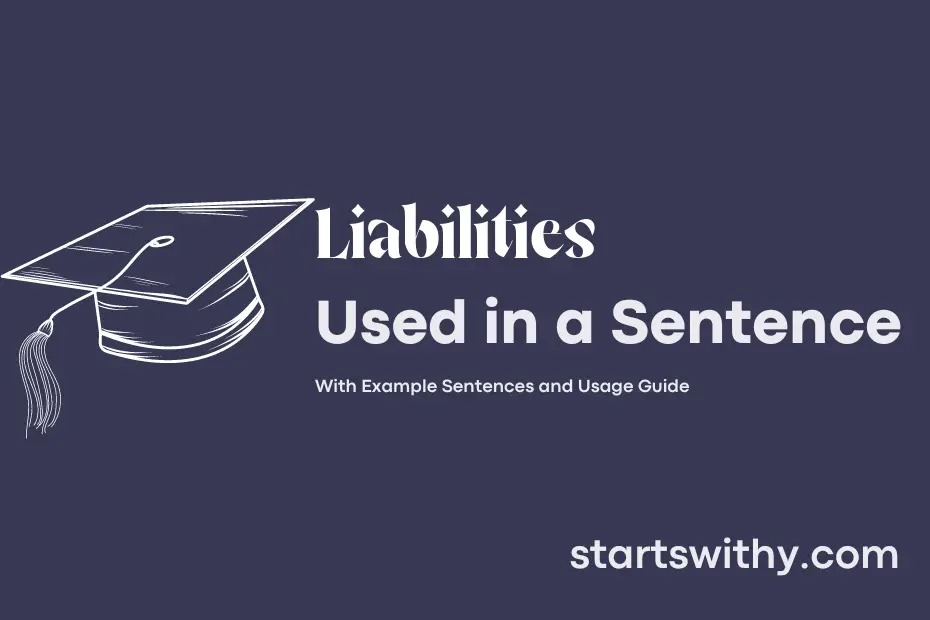Liabilities are financial obligations that an individual or entity owes to others, which typically involve the transfer of assets or provision of services in the future. These can include debts, loans, and other liabilities that must be settled at a future date.
Understanding liabilities is crucial for individuals and businesses alike, as they impact financial stability and strategy. By managing liabilities effectively, one can ensure a healthy balance sheet and avoid financial strain.
7 Examples Of Liabilities Used In a Sentence For Kids
- Liabilities are things you owe someone money for.
- We need to be careful with our liabilities and keep track of them.
- When we borrow something from someone, it becomes our liability.
- It’s important to understand what our liabilities are and how we can manage them.
- Sometimes, liabilities can be a burden, so it’s good to try and reduce them.
- Knowing your liabilities helps you make better decisions with your money.
- By being responsible with our liabilities, we can avoid financial problems in the future.
14 Sentences with Liabilities Examples
- Liabilities such as student loans can often become a burden for college students in India.
- It is important for college students to understand the liabilities they may incur when taking on part-time jobs.
- Always be cautious of the financial liabilities associated with credit card debt as a college student.
- Looking for ways to minimize liabilities can help college students maintain financial stability.
- Understanding the legal liabilities of renting an apartment is crucial for college students in India.
- Failing to manage liabilities properly can lead to financial stress and uncertainty for college students.
- It is advisable for college students to seek guidance on how to handle liabilities when starting a small business.
- Knowledge about tax liabilities is essential for college students who are considering freelance work.
- Keeping track of all your financial liabilities will help you budget effectively as a college student in India.
- Discussing liabilities with roommates before sharing expenses can help avoid conflicts in shared living spaces.
- Be cautious about the potential liabilities of signing a lease agreement for off-campus housing as a college student.
- Understanding the liabilities involved in co-signing for a loan can prevent future financial hardships for college students.
- When participating in group projects, it is important to clearly define each member’s responsibilities and liabilities.
- Seeking legal advice on personal injury liabilities can protect college students from unforeseen expenses in case of accidents.
How To Use Liabilities in Sentences?
Liabilities are financial obligations or debts that a person or business owes to another party. Liabilities can include loans, accounts payable, mortgages, and other financial responsibilities.
When using liabilities in a sentence, it is important to clearly identify the obligation or debt. For example, “The company’s total liabilities exceeded its assets” shows that the company owed more than it possessed.
It is also crucial to specify the amount of the liabilities when mentioning them in a sentence. For instance, “The student loan is a significant liability for recent graduates” highlights the specific debt that needs to be repaid.
Moreover, liabilities should be described in relation to other financial elements, such as assets or equity, to provide context. For instance, “The business owner is concerned about the increasing liabilities and decreasing assets” demonstrates the relationship between debts and resources.
When writing about liabilities, it is beneficial to be concise and clear to ensure that the sentence conveys the financial obligation effectively. Practice using liabilities in various sentences to enhance your understanding of how to incorporate them appropriately in financial contexts.
Conclusion
In conclusion, understanding the concept of liabilities is crucial in financial accounting. Liabilities represent the obligations a company owes to outside parties, such as loans, accounts payable, and accrued expenses. By examining sentences with liabilities, we can see how these financial obligations are recorded and managed in various settings.
From “The company’s balance sheet showed a significant increase in long-term liabilities this quarter” to “The business owner realized the importance of reducing liabilities to improve cash flow”, these examples illustrate the impact liabilities can have on a company’s financial health. Properly managing liabilities is essential for maintaining strong financial stability and ensuring the long-term success of a business.



